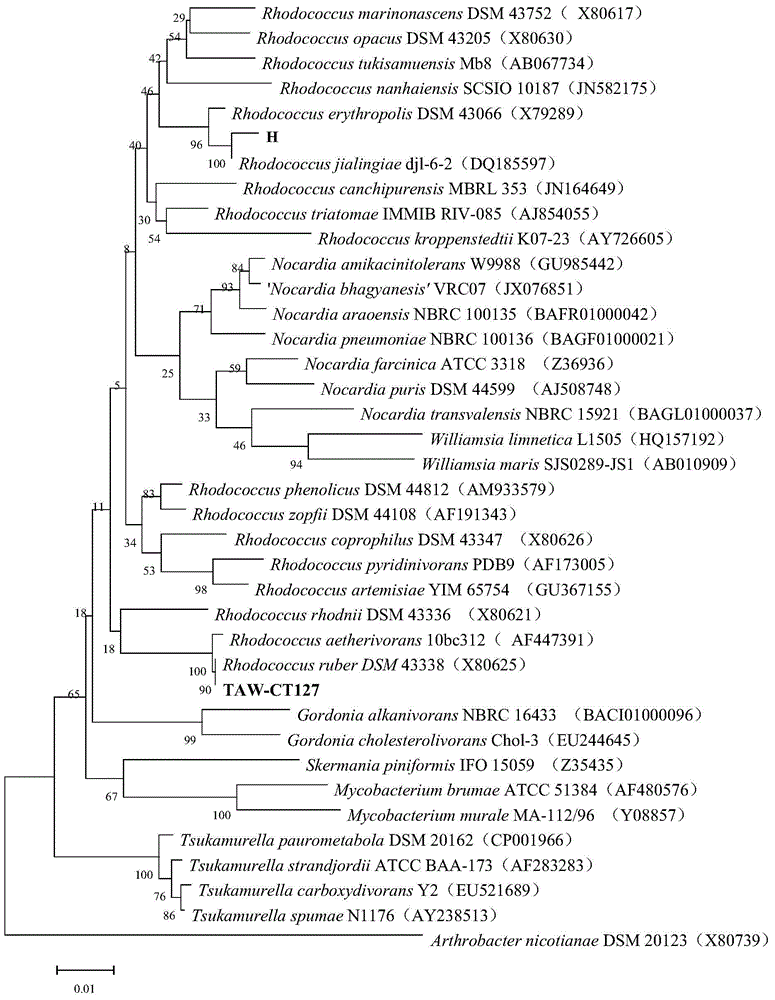Rhodococcus ruber and application thereof in preparing decabromodiphenyl oxide degrading agent
A technology of decabromodiphenyl ether and rhodococcus, applied in rhodococcus and its application in the preparation of decabromodiphenyl ether degradation agent, can solve the problems of weak function and low efficiency of decabromodiphenyl ether
- Summary
- Abstract
- Description
- Claims
- Application Information
AI Technical Summary
Problems solved by technology
Method used
Image
Examples
Embodiment 1
[0023] 1. Enrichment, isolation and identification of Rhodococcus ruber TAW-CT127
[0024] 1. Enrichment, isolation and purification of Rhodococcus ruber TAW-CT127
[0025] Medium:
[0026] Artificial Seawater Medium (MMC): Each liter of medium contains 24g of NaCl, NH 4 NO 3 1g, KCl 0.7g, KH 2 PO 4 2.0g, Na 2 HPO 4 3.0g, pH 7.4, MgSO 4 7g (added after sterilization).
[0027] Trace element salt solution: every liter of trace element salt solution contains 2mg of CaCl, FeCl 3 ·6H 2 O 50mg, CuSO 4 0.5mg, MnCl 2 ·.H 2 O 0.5mg, ZnSO 4 ·.7H 2 O 10 mg.
[0028] Marine bacteria agar 2216 medium and marine bacteria broth 2216 medium were purchased from BD Medical Instruments (Shanghai) Co., Ltd.
[0029] Decabromodiphenyl ether mother liquor: organic solvent dichloromethane (chromatographic grade), decabromodiphenyl ether concentration 1g / L
[0030] The Rhodococcus ruber (Rhodococcus ruber) TAW-CT127 of the present invention is obtained through enrichment, separation...
Embodiment 2
[0042] Degradation Analysis of Decabromodiphenyl Ether by Rhodococcus ruber TAW-CT127
[0043] Artificial Seawater Medium (MMC): Each liter of medium contains 24g of NaCl, NH 4 NO 3 1g, KCl 0.7g, KH 2 PO 4 2.0g, Na 2 HPO 4 3.0g, pH 7.4, MgSO 4 7g (added after sterilization).
[0044] Trace element salt solution: every liter of trace element salt solution contains 2mg of CaCl, FeCl 3 ·6H 2 O 50mg, CuSO 4 0.5mg, MnCl 2 ·.H 2 O 0.5mg, ZnSO 4 ·.7H 2 O 10 mg.
[0045] Enrichment Medium EM (Enrichment Medium): Marine Bacteria Broth 2216 Medium
[0046] Decabromodiphenyl ether degradation medium: 100mL MMC medium + trace elements
[0047] Proliferation culture of Rhodococcus ruber (Rhodococcus ruber) TAW-CT127: Under sterile conditions, inoculate Rhodococcus ruber (Rhodococcus ruber) TAW-CT127 into a 1L sterilized Erlenmeyer flask containing 500mL seawater broth culture (2216) , placed in a constant temperature shaker, 28°C, 160rpm, and cultivated for 48h.
[0048] T...
PUM
 Login to View More
Login to View More Abstract
Description
Claims
Application Information
 Login to View More
Login to View More - R&D
- Intellectual Property
- Life Sciences
- Materials
- Tech Scout
- Unparalleled Data Quality
- Higher Quality Content
- 60% Fewer Hallucinations
Browse by: Latest US Patents, China's latest patents, Technical Efficacy Thesaurus, Application Domain, Technology Topic, Popular Technical Reports.
© 2025 PatSnap. All rights reserved.Legal|Privacy policy|Modern Slavery Act Transparency Statement|Sitemap|About US| Contact US: help@patsnap.com



